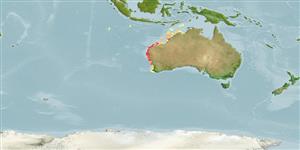>
Syngnathiformes (Pipefishes and seahorses) >
Syngnathidae (Pipefishes and seahorses) > Syngnathinae
Etymology: Hippocampus: Greek, ippos = horse + Greek,kampe = curvature (Ref. 45335); montebelloensis: Named in reference to the Monte Bello Islands, its type locality.
Issue
Kuiter described the species (2001) and endorsed it subsequently (2009) separating it from Hippocampus zebra Whitley, 1964, while Lourie (in two publications in 2016) synonymized it with the latter species. We chose to assign an uncertain status because probably it is a case of sibling species (Kuiter) while we recognized a lack of clear evidence (Lourie) to separate them. Genetic studies have to be performed to take a documented decision.
Environment: milieu / Klimaatzone / Diepte / distribution range
Ecologie
marien pelagic-neritic; standvastig. Tropical
Eastern Indian Ocean: known only from Monte Bello Islands and Exmouth Gulf, Western Australia.
Grootte / Gewicht / Leeftijd
Maturiteit: Lm ? range ? - ? cm
Max length : 7.8 cm OT (female)
Korte beschrijving
Determinatiesleutels | Morfologie | Morfometrie
Dorsale stekels (totaal) : 0; Dorsale zachte stralen (totaal) : 18 - 19. Trunk rings 11; tail rings 37; subdorsal spines 3/0,1,0; spine above eye of moderate size, length about pupil-diameter, slightly angled back; moderately large and recurving lateral head spine; long, forward-directed nape spine; nose profile straight; coronet moderately high, with spines on corners, posterior 3 largest and directed backward; 3 spines of moderate size on shoulder ring, uppermost and central spines at end of pectoral-fin base, lowermost ventrally; superior trunk ridge with spines of small to moderate size on rings 1, 4, 7 and 11, extended by long dermal flaps at spine tips in holotype; superior tail ridge similar to superior trunk ridge, with enlarged spines at regular intervals, becoming progressively smaller posteriorly (Ref. 42735).
Body shape (shape guide): other.
Found on the continental shelf (Ref. 75154). Holotype caught at the surface, clinging to Sargassum fragment (Ref. 42735). Maximum length is based on a straight-line length measurement from upper surface (ignoring spines) of first trunk ring, to tip of tail (Ref. 42735). Ovoviviparous (Ref. 205). The male carries the eggs in a brood pouch which is found under the tail (Ref. 205).
Levenscyclus en paargedrag
Maturiteit | Voortplanting | Paaien | Eieren | Fecunditeit | Larven
Male carries the eggs in a brood pouch (Ref. 205).
Kuiter, R.H., 2001. Revision of the Australian seahorses of the genus Hippocampus (Syngnathiformes: Syngnathidae) with descriptions of nine new species. Rec. Aus. Mus. 53:293-340. (Ref. 42735)
Status op de Rode Lijst van het IUCN (Ref. 130435: Version 2025-1)
Gevaar voor de mens
Harmless
Gebruik door de mens
Tools
Speciale rapporten
Download XML
Internetbronnen
Estimates based on models
Preferred temperature (Ref.
123201): 18 - 27, mean 21.8 °C (based on 111 cells).
Fylogenetische diversiteitsindex (Ref.
82804): PD
50 = 0.5000 [Uniqueness, from 0.5 = low to 2.0 = high].
Bayesian length-weight: a=0.00447 (0.00175 - 0.01142), b=2.99 (2.77 - 3.21), in cm total length, based on LWR estimates for this (Sub)family-body shape (Ref.
93245).
Trofisch niveau (Ref.
69278): 3.4 ±0.5 se; based on size and trophs of closest relatives
Weerstandsvermogen (Ref.
120179): Hoog, minimale populatieverdubbelingstijd minder dan 15 maanden (Preliminary K or Fecundity.).
Fishing Vulnerability (Ref.
59153): Low vulnerability (10 of 100).
🛈
